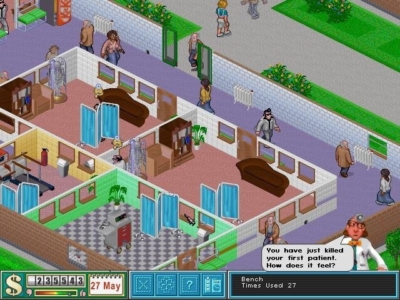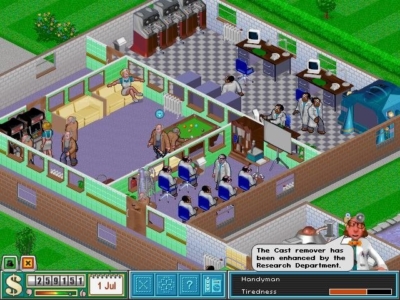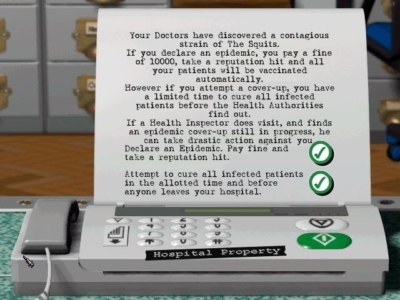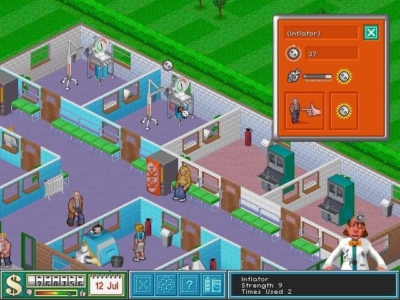
Theme Hospital
Written by: Jo
Date posted: February 13, 2011
- Genre: Strategy
- Developed by: Bullfrog
- Published by: Electronic Arts
- Year released: 1997
- Our score: 7
Opinions are divided on Bullfrog’s 1997 sequel to Theme Park. Some find it addictive, others merely frustrating, and after several (hundred) hours of gameplay I think I’ve figured out why.
Similar in setup to Theme Park, the object is to build a functional hospital, cure patients suffering from a myriad of bizarre diseases (Bloaty Head, The King Complex, The Squits) and maintain a good reputation by keeping patients happy (and alive). I know that makes the game sound comparatively tepid next to building and designing your own roller coasters (as in Bullfrog’s successful predecessor) but I actually find Theme Hospital a much more engaging game.
On each level you need to meet a certain criteria – a good reputation, a healthy bank balance, Hospital value and cure rate – in an attempt to wow the bigwigs at the Health Authority. On satisfying the level criteria, you are then offered a new position at another hospital, bringing with it a new set of challenges and with any luck, a bigger salary.

Just like in Theme Park, the advisor is always on hand to keep you on track and to notify you when you’ve just killed someone. Helpful.
Balancing all this in the first few levels is relatively simple. The day-to-day running of the hospital mainly involves diagnosing and curing the patients whilst simultaneously keeping them happy (by providing plenty of lush foliage), and preventing your staff from feeling undervalued and overworked to keep them from threatening to leave in order to fulfil their lifelong dreams of becoming a computer games producer.
As you progress things not only become a bit more complex in the day-to-day running of the hospital, but a number of impromptu challenges are also presented. Your managerial decision-making abilities have a large effect on the overall running (and success) of your hospital as you make your way through each level. These are communicated to you via faxes popping up in the bottom left-hand corner of the screen – and remain there pending your decision. Initially these amount to extending (or declining) invitations to VIPs to visit your hospital (a successful visit can ramp up your reputation in the community) and having the final say on gambling with a patient’s life by taking a chance on a possible cure after a questionable diagnosis. The impromptu challenges come in the form of being asked to deal with emergencies where patients are flown in by helicopter and you have to cure them against the clock. In later levels, you have to deal with epidemics, which even now, I can’t really explain because even after hours and hours of gameplay, I’m still not really sure what differentiates successfully dealing with an epidemic from failing to do so. Dealing with an emergency/epidemic successfully can give you a cash and reputation boost and vice versa if you fail.

In one room, lazy Junior’s are rigorously trained into the efficient consultants of tomorrow. Next door – the nurses are playing video games.
Other spontaneous problems come, oddly, in the form of recurrent natural disasters. I’m not sure whether all the hospitals are built on the San Andreas fault line, but every level sees its fair share of earthquakes. Thankfully they don’t harm your staff and patients, but they can completely wreck your equipment if it isn’t properly maintained. Frustratingly, this means you have to ensure your handymen are constantly repairing your equipment to ensure it doesn’t spontaneously combust rendering the room and space completely useless. It’s not too big a deal, but it does get a little tedious, especially if you’ve got lots of equipment and adjusting the handymen’s priorities to focus on maintenance makes absolutely no difference.
I only recently learned how much strategy goes into playing Theme Hospital. As with any Godgame, there’s a strategy beneath the strategy. It isn’t enough to build rooms and hire doctors to work in them, you’ve also got to figure out what your most common emergency is, build enough rooms so you can deal with it, and build them close to the helicopter pad. Then there’s everything else from figuring out how skilled/expensive/efficient your doctors are going to be, how you’re going to train them and who’s going to work in your research department, to how many benches you place outside each treatment room and where you place the furniture/equipment in each room to make the diagnosis as streamlined as possible. Thinking of every contingency is part and parcel of Godgames, and while Theme Hospital isn’t a super-serious management sim, that’s not to say that it isn’t worth giving all this strategy-stuff some serious thought if you want to progress.

All of your managerial decisions come in the form of a fax. In this case, you have a choice to declare and epidemic of The Squits and pay a $10,000 fine, or attempt to cover it up.
But this is exactly where the game fails, and I think that for many it’s possibly where the frustrating part comes in. It all comes down to the somewhat clunky AI. All the strategy in the world doesn’t seem to have made a bit of difference when you’ve got a top-skilled Psychiatrist Consultant leaving the Psychiatrist’s office and heading to the GP’s office (where a low-paid junior should be working) past a corridor of emergency patients dressed up as Elvis – desperately seeking some speedy Psychiatric help. I’m damned if I know how to keep him in the office short of building a room with a door that can only be opened from the outside.
And it’s not just the staff who are tremendously stupid and a law unto themselves, because the patients are just as hopeless. Even if your staff don’t insist on leaving the room for no apparent reason, things can and will still go awry during emergencies. Despite building two treatment rooms next to one another, each with an attentive medical practitioner inside, emergency patients will not distribute themselves equally between the two rooms. Say you’ve got 11 patients with the enticingly-named illness “The Squits”, don’t assume that 5 will queue at one pharmacy and 6 at the other just because you’ve strategically built them that way for exactly this type of circumstance. In theory, that’s how your strategic placement of the rooms is supposed to work, but rarely does. More often than not, your dim-witted emergency patients will queue up at one pharmacy, while their last remaining moments fall away from them. Meanwhile, in a neighbouring pharmacy housing life-saving drugs, a nurse stares into space and after a while, wanders aimlessly back to the staff room for a cup of tea, just as seven Squits patients fall down dead in the corridor.
Anyway, back to some good features. It’s worth pointing out how great the simplicity of the interface is in Theme Hospital. Similar to Theme Park, everything is contained in a task bar along the bottom of the screen, leaving the rest of the screen free for building in. The task bar is essentially your ‘control desk’ for the game: here you can (amongst other things) build/edit rooms, hire/manage staff, borrow money and check your ‘win’ criteria.

An annoying, monotonous feature of the game is to endlessly page your handymen to fix the machinery before they explode during an earthquake. The machinery that is. Not the handymen.
The graphics are a massive step forward from the pixelated jungle in the 1994 predecessor (I’m talking about during actual gameplay here, not about the cutscenes – and yes we were all impressed by the little boy and his dog on the bouncy castle), so much so that it doesn’t particularly feel like you’re playing a game that’s over a decade old [Maybe that’s because you only play games that are at least a decade old – Rik].
The music is every bit as catchy as the plinky plonky soundtrack from Theme Park (and just as likely to start looping through your head during a meeting about an upcoming restructure at work). While there isn’t much actual dialogue, what little voice acting there is (a constant stream of tannoy announcements) is excellently done, although it does get pretty annoying after a while.
While some maintain that Theme Park is the better game, I still prefer Theme Hospital‘s slightly less serious tone, and more clearly defined level structure. I’m not under any illusion I’ll ever complete it, however, but that’s not to say it isn’t enjoyable enough to dip in and out of every now and again. The only disappointment is the wonky AI, which often means that there’s no correlation between your strategy and the actual gameplay. It’s a pretty big problem if you actually aim to complete the game, because you’re not going to do it without getting so frustrated you cause yourself an injury. And then you’ll have to go to an actual hospital, which is even less fun.


 Posts
Posts